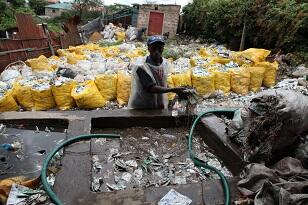What is the market for environmental goods and services in Africa?
Environmental concerns are driving global demand for a wide range of Environmental Goods and Services (EGS). The German Institute for Economic Research (DIW) has estimated that global spending on EGS could rise from USD 584 billion in 2004 to as high as USD 1902 billion by 2020. The size of the EGS industry today has already been compared to the aerospace and pharmaceutical sectors.
The OECD defines the EGS industry as consisting of activities “that produce goods and services to measure, prevent, limit, minimise or correct environmental damage to water, air, soil, as well as problems related to waste, noise and eco-systems. This includes cleaner technologies, products and services that reduce environmental risk and minimize pollution and resource use”. Given the very broad scope of the definition, here are just a few examples of what this can include:
- Waste management - products and services for the collection, disposal and treatment of municipal, commercial and industrial waste.
- Environmental analysis and assessment - products and services for the monitoring of environmental standards and conditions.
- Resource management e.g. recycled materials, nature protection.
- Climate-friendly goods technologies and related services: e.g. solar panels.
A young man cleans recycle plastic bag in Dandora dumping site Nairobi
Image: UN-HABITAT, flickr
What is the trade in EGS in developing countries?
Despite these potentials we know very little about the challenges and opportunities for trade in EGS in developing countries, even though this is where the largest growth potential lies. This is in part due to the lack of an internationally accepted categorization of EGS as well as the related difficulty of gathering reliable and comparable data on trade-flows. This in turn has led policy makers to often overlook a sector with substantial economic and environmental benefits.
ITC’s Trade and Environment Unit is carrying out a background study of the EGS trade in Africa, and some interesting facts include:
Export Potential
- Developing countries, while starting from a small share of the global environmental market, have experienced the fastest growth rates. Africa’s sector grew annually by 11 % from 2000-06.
- In travel and tourism -- a priority sector for many African countries-- environmental services can help manage the environmental impact of tourism for example the protection of coral reefs or natural parks.
- The South African EGS market (estimated at nearly USD 3.8billion) includes subsectors such as water, waste management and resource management.
- South Africa is also leader in specific niche areas such as management of mine waste, mine rehabilitation and conservation and biodiversity management.
- The recycling business is lucrative, with the industry globally making an annual turnover of more than USD 200 billion.
Import Angle
- Developing countries are net importers of EGS, particularly of infrastructural environmental services. These require high levels of investment and expertise. Developing countries can benefit from such investments through commercial presence (e.g. in Morocco 80% of waste collection and landfilling market is served by four subsidiaries of international groups).
- ACP countries tend to have higher tariffs on EG products than most of their trade partners. Market opening may be a good initiative to promote greater use of environmental goods.
Regulation and informal sectors
- The collection and recycling of 90% of waste in Morocco is mainly performed by the informal sector.
- The majority of E-waste is not recycled and some have estimated that around 80% is exported to Africa, China or India where environmental regulation is often less stringent (Schmidt, 2006)
Knowledge gaps
These facts point to a sector where trade could play a significant role: in terms of export potential as well as in helping to meet environmental goals through imports. Another conclusion coming out of the review is that more analysis is needed to highlight where trade potentials exist as well as the barriers faced by enterprises wishing to take advantage of these.
Back to the main page of ITC environment blog.
You can also follow Alex on Twitter




